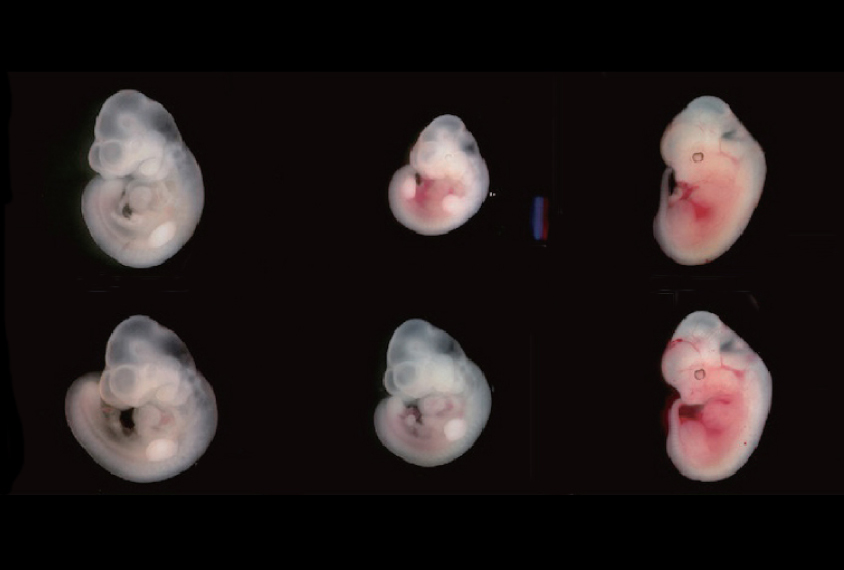
THIS ARTICLE IS MORE THAN FIVE YEARS OLD
This article is more than five years old. Autism research — and science in general — is constantly evolving, so older articles may contain information or theories that have been reevaluated since their original publication date.
Edging out at least five other teams, a Japanese group last week became the first to publish findings on mice lacking CHD8, the leading candidate gene for autism risk1.
Their mice show some autism-like features: They are anxious and do not seem to recognize mice they have previously met.
“We concluded that CHD8 mutant mice have some deficit in social communication,” says lead researcher Keiichi Nakayama, professor of molecular and cellular biology at Kyushu University in Japan.
Yet the findings, published 7 September in Nature, are at odds with unpublished reports of other mice lacking CHD8. For example, California-based researchers reported in May that their mice behave like typical mice on tests of social behavior. A London-based team also has not seen signs of social oddities in their mice, says the team’s leader Albert Basson, reader in developmental and stem cell biology at King’s College London.
The differences may be a matter of interpretation. The behaviors of the CHD8 mice in Japan are atypical, but do not resemble autism features, says Basson. “I’m not saying the tests and the data are wrong. It’s just a bit of a push to say these mice have autism-like behaviors,” he says.
Social quirks:
Nakayama’s team was studying CHD8 at least a decade before anyone connected it to autism. CHD8 controls the expression of thousands of genes, and Nakayama’s group was exploring its role in cancer.
In 2002, the researchers created mice lacking both copies CHD8. These mice die in utero2. Scientists first found a harmful mutation in CHD8 in two people with autism in 2012. They have since identified at least 26 people with CHD8 mutations, 24 of whom have autism. (The remaining two individuals have not been assessed and may also have autism.)
The findings prompted Nakayama’s team to look at mice that lack only one copy of CHD8, which mimics the situation in people. The mice are anxious, avoiding the center of an open field. They also show behavior reminiscent of restricted interests: When researchers move the location of a treat in a maze, the mice sometimes go to the old location.
Compared with controls, the mutant mice initiate fewer interactions with other mice — although the interactions they do have are longer than usual — and they don’t show a preference for unfamiliar mice.
However, the researchers did not test the mutants’ sense of smell; impaired smell could prevent the animals from recognizing mice they have previously met, says Jill Silverman, assistant professor of psychiatry and behavioral sciences at the University of California, Davis. Silverman is part of the California team working on CHD8 mice.
Master regulator:
Nakayama’s team also looked at CHD8’s effects on gene expression. They found that about 70 percent of the protein binds to certain regions that modulate gene expression, even though these regions constitute only 3 percent of the genome. CHD8 also binds near half of all autism-related genes. In fetal mice, loss of one copy of CHD8 seems to delay expression of genes important for mid-fetal development.
The mutant mice also show a slight shift in the levels of hundreds of genes, bolstering the case for CHD8 as a master regulator of gene expression. “Accumulation of many, many small changes probably causes autism,” says Nakayama.
These findings are in line with those seen in human stem cells in which CHD8 expression is suppressed, says Michael Talkowski, associate professor of neurology at Harvard University, who was not involved in the work. Talkowski plans to compare his stem cell data with the mouse findings to look for common CHD8 targets. “It will be exciting to see if we can really narrow down the most robust binding sites for CHD8,” he says.
The findings are based on brain tissue as a whole, which could mask bigger changes in gene expression in certain cells or brain regions, says James Noonan, associate professor of genetics at Yale University, who was not involved in the new study. Noonan is also studying the effects of CHD8 on gene expression.
Nakayama’s team is already studying mice that lack a copy of CHD8 in subtypes of brain cells. “We would like to know what types of cells are responsible for autism development,” he says.
The researchers also plan to restore CHD8 expression in their mutants. If the treatment normalizes the mice’s behavior, something similar might work for people with CHD8 mutations, Nakayama says.
Researchers say the next few months are likely to bring an onslaught of additional CHD8 publications. “There’s enough to do with these models that everyone who has their own model is going to be able to contribute something,” Noonan says.
By joining the discussion, you agree to our privacy policy.